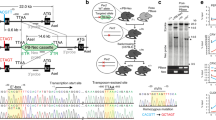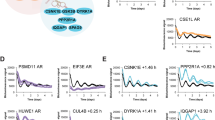Abstract
Heterodimers of CLOCK and BMAL1, bHLH-PAS transcription factors, are believed to be the major transcriptional regulators of the circadian clock mechanism in mammals. However, a recent study shows that CLOCK-deficient mice continue to exhibit robust behavioral and molecular rhythms. Here we report that the transcription factor NPAS2 (MOP4) is able to functionally substitute for CLOCK in the master brain clock in mice to regulate circadian rhythmicity.
This is a preview of subscription content, access via your institution
Access options
Subscribe to this journal
Receive 12 print issues and online access
$209.00 per year
only $17.42 per issue
Buy this article
- Purchase on Springer Link
- Instant access to full article PDF
Prices may be subject to local taxes which are calculated during checkout



Similar content being viewed by others
References
Lowrey, P.L. & Takahashi, J.S. Annu. Rev. Genomics Hum. Genet. 5, 407–441 (2004).
Reppert, S.M. & Weaver, D.R. Nature 418, 935–941 (2002).
DeBruyne, J.P. et al. Neuron 50, 465–477 (2006).
Bunger, M.K. et al. Cell 103, 1009–1017 (2000).
Rutter, J., Reick, M., Wu, L.C. & McKnight, S.L. Science 293, 510–514 (2001).
Zhou, Y.-D. et al. Proc. Natl. Acad. Sci. USA 94, 713–718 (1997).
Hogenesch, J.B. et al. J. Biol. Chem. 272, 8581–8593 (1997).
Reick, M., Garcia, J.A., Dudley, C. & McKnight, S.L. Science 293, 506–509 (2001).
Shearman, L.P., Zylka, M.J., Reppert, S.M. & Weaver, D.R. Neuroscience 89, 387–397 (1999).
Garcia, J.A. et al. Science 288, 2226–2230 (2000).
Dudley, C.A. et al. Science 301, 379–383 (2003).
Green, C.B. & Menaker, M. Science 301, 319–320 (2003).
Welsh, D.K., Yoo, S.H., Liu, A.C., Takahashi, J.S. & Kay, S.A. Curr. Biol. 14, 2289–2295 (2004).
Acknowledgements
We thank C.M. Lambert for technical assistance, and S.L. McKnight and J.S. Takahashi for providing the mice we used to establish colonies of Npas2 mutant mice and mPer2::Luciferase reporter mice, respectively. This work was supported by US National Institutes of Health (NIH) grants R01 NS047141 (S.M.R.) and R01 NS056125 (D.R.W.). J.P.D. was supported in part by NIH National Research Service Award F32 GM074277.
Author information
Authors and Affiliations
Corresponding author
Ethics declarations
Competing interests
The authors declare no competing financial interests.
Supplementary information
Supplementary Fig. 1
Raw luciferase activity data from the SCN prior to normalization and 24-h trend subtraction. (PDF 104 kb)
Supplementary Fig. 2
Quantitative real time PCR (qPCR) detection of Npas2 expression in the SCN. (PDF 56 kb)
Rights and permissions
About this article
Cite this article
DeBruyne, J., Weaver, D. & Reppert, S. CLOCK and NPAS2 have overlapping roles in the suprachiasmatic circadian clock. Nat Neurosci 10, 543–545 (2007). https://doi.org/10.1038/nn1884
Received:
Accepted:
Published:
Issue Date:
DOI: https://doi.org/10.1038/nn1884
This article is cited by
-
Sex differences in the tumor promoting effects of tobacco smoke in a cRaf transgenic lung cancer disease model
Archives of Toxicology (2024)
-
Circadian rhythms in the blood–brain barrier: impact on neurological disorders and stress responses
Molecular Brain (2023)
-
Artificial induction of circadian rhythm by combining exogenous BMAL1 expression and polycomb repressive complex 2 inhibition in human induced pluripotent stem cells
Cellular and Molecular Life Sciences (2023)
-
Circadian clocks, cognition, and Alzheimer’s disease: synaptic mechanisms, signaling effectors, and chronotherapeutics
Molecular Neurodegeneration (2022)
-
Mammalian PERIOD2 regulates H2A.Z incorporation in chromatin to orchestrate circadian negative feedback
Nature Structural & Molecular Biology (2022)



